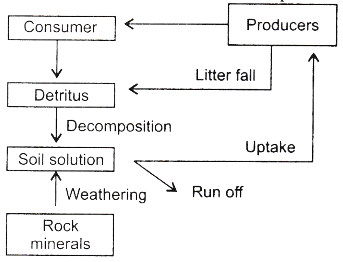Recycling of phosphorus : Phosphorus is a major constituent of biological membranes, nucleic acids and cellular energy transfer system. The natural reservoir of phosphorus is rock, which, contains phosphorus in the form of phosphates. When rocks are weathered, minute amount of these phosphates dissolve in soil solution and are absorbed by the roots of the plants. Herbivores and other animals obtain this element from plants. Herbivores and other animals obtain this element from plants. The waste products and the dead organisms are decomposed by phosphate-solubilizing bacteria releasing phosphorus. Unlike carbon cycle, there is no respiratory release of phosphorus into atmosphere.

Differences between carbon and phosphorus cycle : The major and important differences between carbon and phosphorus cycle are, firstly, atmospheric inputs of phosphorus through rainfall are much smaller than carbon inputs, and secondly, gaseous exchanges of phosphorus between organism and environment are negligible.
| S.No. |
Characters |
Carbon cycle |
Phosphorus cycle |
| 1. |
Amount of atmospheric input |
More in amounts |
Less in amounts |
| 2. |
Degree of exchanges between organism and environment |
High |
Negligible |
| 3. |
Nature of cycle |
Perfect cycle |
Imperfect cycle |